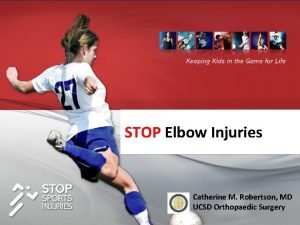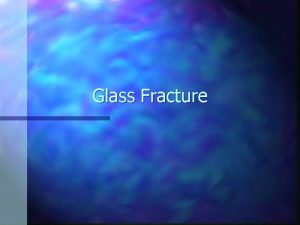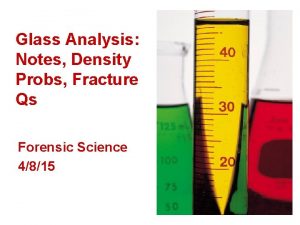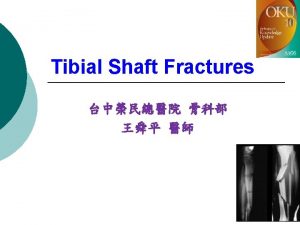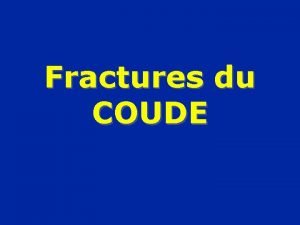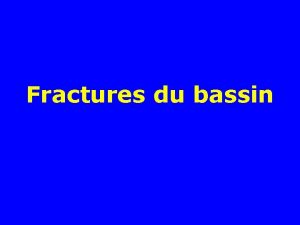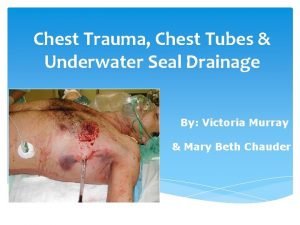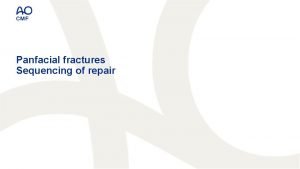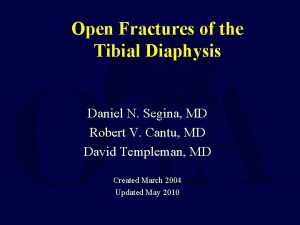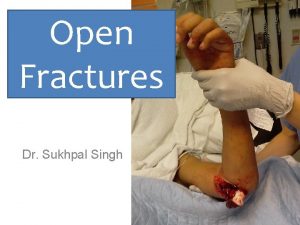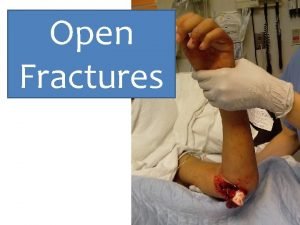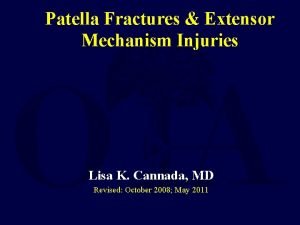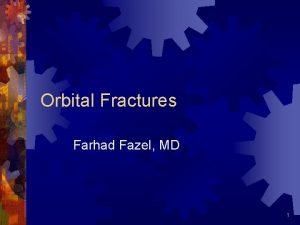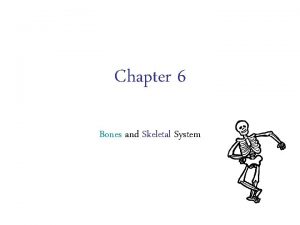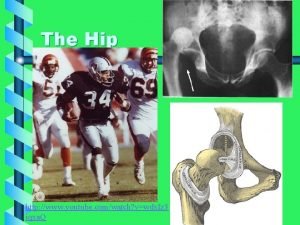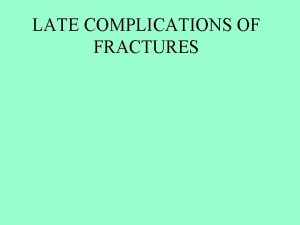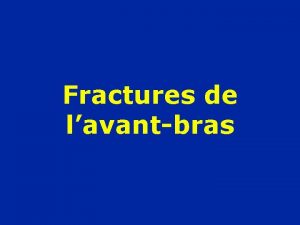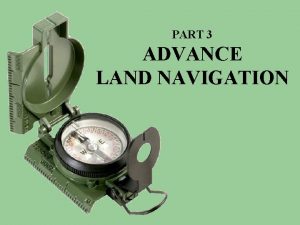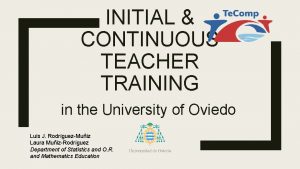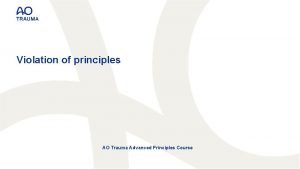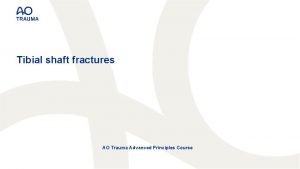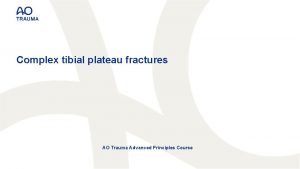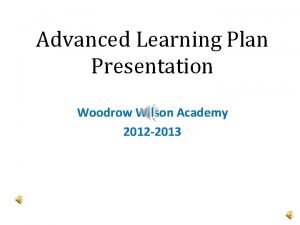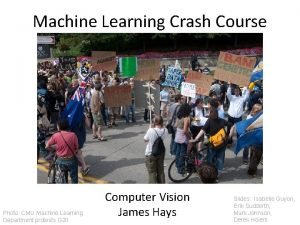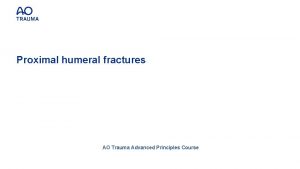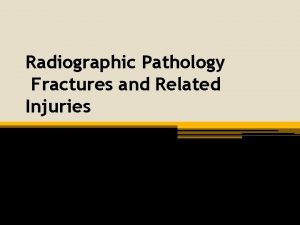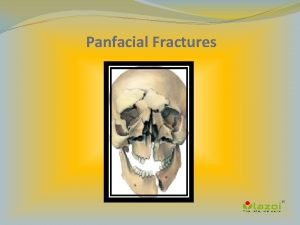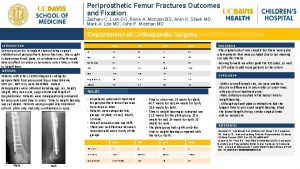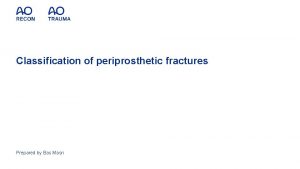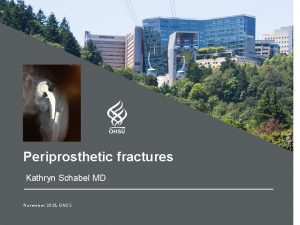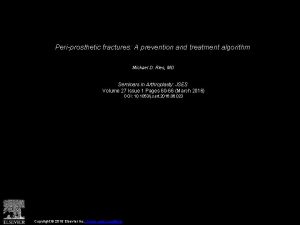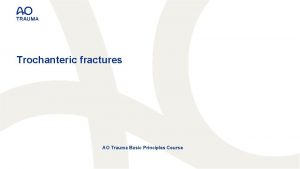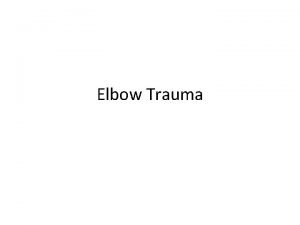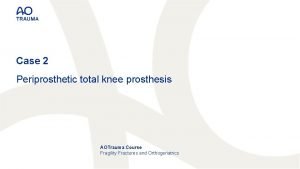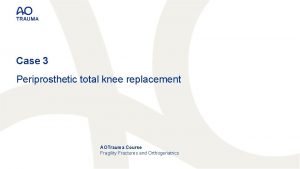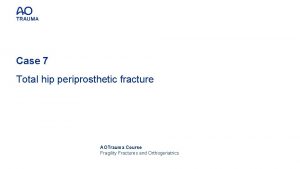Periprosthetic fractures AO Trauma Advanced Principles Course Learning







































- Slides: 39

Periprosthetic fractures AO Trauma Advanced Principles Course

Learning objectives • Indicate the incidence of these fractures • Outline relevant classification systems for femoral periprosthetic fractures • Evaluate application of modern biological techniques • Analyze current evidence for surgical management • Explore key outcome publications

Periprosthetic femoral fractures • • Incidence—primary • Intraoperative cemented: 3%, uncemented: 0. 23% • Postoperative Incidence—revision • Intraoperative cemented: 6%, uncemented: 19% • Postoperative rate no difference

Diagnosis and classification • “Unified” or “comprehensive” classification system* for all periprosthetic fractures *Duncan, Haddad, Perka, Schütz 2012 Joints: I Shoulder II Elbow III Wrist IV Hip V Knee VI Ankle Bones: According to AO/OTA Classification Types: A-E “Vancouver”

Comprehensive Classification System (CCS) IV. 3 -A

Comprehensive Classification System (CCS) IV. 3 - B 1 Well fixed prosthesis IV. 3 - B 2 Prosthesis loose, but good bone IV. 3 - B 3 Prosthesis loose, poor bone

Comprehensive Classification System (CCS) IV. 3 - C: distant to THA IV. 3 - D: intercalary close to TKA

General management principles • Early mobility—avoid traction and bed rest • Minimize surgical trauma • Compromise if necessary

General management principles • • If the stem is loose, revise the stem • If isthmus is intact, tapered fluted stem • If isthmic fit can be achieved, distally locked porous/HA coated stem or long cemented stem The proximal tube of bone must be reconstructed around the implant to prevent stem fracture

General management principles • Consider supplemental fixation • • Lateral locked plate spanning the length of the femur. Strut grafts Not necessary for the majority of cases where isthmus is intact and a good distal fix can be achieved Consider acetabular revision • • Polyethylene is worn Preoperative symptoms of loosening Infection High risk of dislocation

Failed rigid fixation • Biomechanical principles • Attempted absolute stability • Stress concentration at tip of prosthesis led to failure

Preoperative plan: option 1 • Relative stability • Create a long construct, trochanter to condyle avoiding stress concentration • Lateral locking plate

Preoperative plan: option 2 • Revision to a modular tapered, fluted stem • Aiming to achieve distal isthmic fixation with the stem • Reconstitution of the femoral tube proximally • +/- lateral plate

Option 2

General management principles Preserve total hip replacement longevity • Change scratched head • Change worn poly • Dual mobility/constrained options if dislocation is a risk Know what components you need before surgery!

• 101 -year-old patient • Type B 1 fracture • Lives in a nursing home • Uses walking frame • ASA III

Goal of treatment • Early mobilization out of bed • Stable fixation Principles of fixation • Long implants bridging the femur • Proximal fixation options: VA screws, cables • Open reduction techniques when fractures will not reduce closed • Consider screws or cerclage wires to hold the reduction prior to plate application

Strongest • Locking screws • Locking attachment plates • Cables • Wires Weakest



• Distal approach to insert plate • Proximal open approach to position plate and apply supplementary fixation options

• Precontoured plates sometimes need adjustment to the situation and anatomy

• Select the right length of plate • Position plate




• 91 -year-old patient • Type B 2 fracture • Lives with retired daughter • Wheelchair bound • ASA IV

• Preoperative plan? • Keep patient alive, maintain ability to transfer, minimize surgery, and keep implant • Relative stability • Lateral plate (lateral) + strut (medial or anterior) • Immediate mobility

Type B 2—preoperative plan • Relative stability • Intramedullary fixation (new stem) • Supplemental extramedullary fixation • Lateral plate • Medial/anterior strut

Technique Option 1: Reconstruct tube around new implant Option 2: Place new implant into reconstructed tube Option 2 shown

Option 2: fixing the tube first

Reconstituting the tube first: intracortical screws • Not reported • Avoid excessive stripping • • AO reduction “towel clips” only—no lobster claws, etc 2 mm screws • Drill through with 1. 1 mm first, then over drill

Reconstituting the tube Lateral plate (or strut) • Proximal cerclage wires • Distal screws if possible Cortical strut • (Medial or anterior) • Shaped with burr to fit • Bone graft around edges

Type C: fix the fracture • • Osteoporotic bone • IM fixation • Fixed-angle device • Locking plates • DCS • Blade plate Poor biology (age, illness) • Minimize stripping • Consider augmentation with strut

• Open reduction of fracture with cerclage fixation • Positioning and fixation of plate


• IV. 3 -D: intercalary close to THA • Use of cerclage wire • Either to facilitate reduction • Or improve fixation around the femur

Take-home messages • Consider patient factors • Balance early mobility against the effects of major surgery • Decision making influenced by stability of prosthesis!

Take-home messages • If prosthesis is stable, then fixation of fracture (mostly extramedullary implants) • If possible, bridge the whole bone with the fixation • Consider medial or anterior strut • If prosthesis is loose, change loose stem: long IM fixation • Fix tube first or wrap around new implant (burr needed) • Augment with extramedullary fixation • Revision longevity: change scratched head and worn poly in virtually all cases
 Tennis elbow irving
Tennis elbow irving Concentric fracture glass
Concentric fracture glass Radial fractures in glass
Radial fractures in glass Ao classification of fractures
Ao classification of fractures Classification fracture supracondylienne
Classification fracture supracondylienne Disjonction symphyse pubienne classification
Disjonction symphyse pubienne classification Bubbles in chest tube
Bubbles in chest tube Bone cancer fractures
Bone cancer fractures Panfacial fractures sequencing
Panfacial fractures sequencing Daniel tibia
Daniel tibia Dr sukhpal singh
Dr sukhpal singh Open fracture treatment
Open fracture treatment Lisa kasman
Lisa kasman Canthatomy
Canthatomy Types of fractures with pictures
Types of fractures with pictures Youtube
Youtube Acetabular fractures
Acetabular fractures Types of glass fractures
Types of glass fractures Perkins timetable of fracture healing
Perkins timetable of fracture healing Bobine d'andrieu
Bobine d'andrieu Weber classification of ankle fractures
Weber classification of ankle fractures Advanced malware analysis course
Advanced malware analysis course Basic instructor course #1014
Basic instructor course #1014 Advanced land navigation
Advanced land navigation Advanced maxqda course
Advanced maxqda course Tcole advanced instructor course
Tcole advanced instructor course Tcole advanced instructor course
Tcole advanced instructor course Ao advanced course
Ao advanced course Cuadro comparativo de e-learning
Cuadro comparativo de e-learning How to install a lintel in a single brick wall
How to install a lintel in a single brick wall Course title and course number
Course title and course number Course interne moyenne externe
Course interne moyenne externe Advanced principles of fracture management
Advanced principles of fracture management Advanced principles of fracture management
Advanced principles of fracture management Advanced principles of fracture management
Advanced principles of fracture management Wwa academy
Wwa academy Advanced machine learning kth
Advanced machine learning kth Facilitator course distance learning
Facilitator course distance learning Cmu machine learning course
Cmu machine learning course Nau igp
Nau igp
